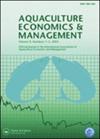越南南美白对虾集约养殖技术与规模效益的数据包络分析
IF 3.7
2区 经济学
Q1 AGRICULTURAL ECONOMICS & POLICY
引用次数: 8
摘要
集约化虾生产是增加出口数量和实现越南2020-2030年国家出口目标的潜在途径。越南农民需要有效地管理他们的虾养殖,以在全球市场上竞争。本研究旨在调查越南虾养殖实践中投入和产出特定技术和规模效率低下及其决定因素。该研究对来自越南金瓯省、江西省和上庄省的200名虾农进行了调查,并采用了一种两阶段方法,采用罗素型(投入产出)方向距离函数来衡量投入和产出特定的技术效率低下,并采用自引导截断回归来探索效率低下的决定因素。结果表明,越南集约化白腿对虾养殖场技术效率低下的主要驱动因素是能源管理不当(效率低下32%)、种子管理不当(效率低下22%)和对虾产量管理不当(效率低下88%)。此外,在虾类养殖方面有经验的男性养殖者,经过适当的培训和使用塑料衬里的池塘,通常在管理池塘区域、使用种子、饲料和劳动力方面做得更好。技术创新、更好的后期幼虫质量及其放养管理有助于提高对虾养殖性能。本文章由计算机程序翻译,如有差异,请以英文原文为准。
Technical and scale efficiency of intensive white-leg shrimp (Litopenaeus vannamei) farming in Vietnam: A data envelopment analysis
Abstract Intensive shrimp production is a potential pathway to increasing export quantity and meeting Vietnamese national export targets set for the 2020–2030 period. Vietnamese farmers need to efficiently manage their shrimp farming to compete in global markets. This study aims to investigate input- and output-specific technical and scale inefficiencies in Vietnamese shrimp farming practice and their determinants. The research used a survey among 200 shrimp farmers from Ca Mau, Kien Giang, and Soc Trang provinces in Vietnam, and applied a two-stage approach with a Russell-type (input–output) directional distance function for measuring input- and output-specific technical inefficiency, and a bootstrap truncated regression for exploring the determinants of inefficiencies. Results show that main drivers of technical inefficiencies in Vietnamese intensive white-leg shrimp farms are inappropriate management of energy (inefficiency of 32%), seed (inefficiency of 22%) and shrimp yield production (88%). Furthermore, male farmers experienced in shrimp farming, with proper training and applied plastic-lined ponds are generally better in managing pond areas, use of seed, feed, and labor. Technological innovations, better post larvae quality and their stocking management can help to improve shrimp farming performance.
求助全文
通过发布文献求助,成功后即可免费获取论文全文。
去求助
来源期刊

Aquaculture Economics & Management
FISHERIES-
CiteScore
7.30
自引率
17.90%
发文量
21
期刊介绍:
Aquaculture Economics and Management is a peer-reviewed, international journal which aims to encourage the application of economic analysis to the management, modeling, and planning of aquaculture in public and private sectors. The journal publishes original, high quality papers related to all aspects of aquaculture economics and management including aquaculture production and farm management, innovation and technology adoption, processing and distribution, marketing, consumer behavior and pricing, international trade, policy analysis, and the role of aquaculture in food security, livelihoods, and environmental management. Papers are peer reviewed and evaluated for their scientific merits and contributions.
 求助内容:
求助内容: 应助结果提醒方式:
应助结果提醒方式:


